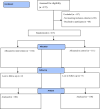Chronic pain following totally extra-peritoneal inguinal hernia repair: a randomized clinical trial comparing glue and absorbable tackers
- PMID: 37170003
- PMCID: PMC10174730
- DOI: 10.1007/s00423-023-02932-2
Chronic pain following totally extra-peritoneal inguinal hernia repair: a randomized clinical trial comparing glue and absorbable tackers
Abstract
Purpose: Chronic pain following inguinal hernia repair occurs in up to 20% of patients. The underlying mechanism probably involves sensory nerve damage and abnormal healing that might be influenced by the materials chosen for mesh fixation. The main objective of this study was to compare glue and absorbable tackers on the rate of chronic pain after surgery in patients undergoing totally extraperitoneal inguinal hernia repair (TEP).
Methods: Patients undergoing (TEP) inguinal hernia repair were enrolled in a single-blind randomized clinical trial and were randomized for mesh fixation with glue (LIQUIBAND FIX 8 Neopharm) or absorbable tackers (SECURE STRAP Johnson & Johnson). Pain was assessed using a validated 4-point verbal-rank scale (none, mild, moderate, and severe) at 1 week, 1 month, 6 months, and 1 year postoperatively. Chronic pain was defined as pain persisting beyond 3 months.
Results: Two hundred and eight patients were analyzed. The groups were similar in age, gender, and hernia side. Chronic pain of any intensity was reported in 31.7% (66/208) after 6 months and in 13% (29/208) after 12 months. No differences in postoperative pain were observed between the two forms of mesh fixation. Still, when only those with severe pain were considered, mesh fixation with glue resulted in less pain compared to fixation by tackers (log-rank p = 0.025). At 1 year, 4 symptomatic recurrent hernias were identified in patients whose mesh was fixated with absorbable tackers.
Conclusions: Patients who underwent TEP inguinal hernia repair with mesh fixated by glue suffered from less pain.
Keywords: Chronic pain; Endoscopic hernia repair; Inguinal hernia.
© 2023. The Author(s), under exclusive licence to Springer-Verlag GmbH Germany, part of Springer Nature.
Conflict of interest statement
The authors declare no competing interests.
Figures
Similar articles
-
Glue versus tackers for mesh fixation in laparoscopic inguinal hernia repair: a meta-analysis and trial sequential analysis.Hernia. 2025 Apr 5;29(1):134. doi: 10.1007/s10029-025-03315-w. Hernia. 2025. PMID: 40186768 Free PMC article.
-
Fibrin glue versus staple mesh fixation in single-port laparoscopic totally extraperitoneal inguinal hernia repair: A propensity score-matched analysis.Int J Surg. 2018 May;53:32-37. doi: 10.1016/j.ijsu.2018.01.029. Epub 2018 Feb 2. Int J Surg. 2018. PMID: 29410137
-
Review of 1000 fibrin glue mesh fixation during endoscopic totally extraperitoneal (TEP) inguinal hernia repair.Surg Endosc. 2016 Oct;30(10):4544-52. doi: 10.1007/s00464-016-4791-3. Epub 2016 Feb 19. Surg Endosc. 2016. PMID: 26895903
-
A comprehensive study comparing tack and glue mesh fixation in laparoscopic total extraperitoneal repair for adult groin hernias.Surg Endosc. 2020 Oct;34(10):4486-4493. doi: 10.1007/s00464-019-07234-7. Epub 2019 Nov 18. Surg Endosc. 2020. PMID: 31741160
-
Mesh fixation techniques for inguinal hernia repair: an overview of systematic reviews of randomised controlled trials.Hernia. 2022 Aug;26(4):973-987. doi: 10.1007/s10029-021-02546-x. Epub 2021 Dec 14. Hernia. 2022. PMID: 34905142 Free PMC article. Review.
Cited by
-
A novel laparoscopic inguinal hernia repair technique: single-port lateral non-abdominal pre-peritoneal approach.Langenbecks Arch Surg. 2023 Jun 5;408(1):224. doi: 10.1007/s00423-023-02964-8. Langenbecks Arch Surg. 2023. PMID: 37272998
-
Safety and efficacy revisited: a systematic review and meta-analysis of glue versus tack mesh fixation in laparoscopic inguinal herniorrhaphy.Front Surg. 2024 Feb 9;11:1321325. doi: 10.3389/fsurg.2024.1321325. eCollection 2024. Front Surg. 2024. PMID: 38404293 Free PMC article. Review.
-
Modern Perspectives on Inguinal Hernia Repair: A Narrative Review on Surgical Techniques, Mesh Selection and Fixation Strategies.J Clin Med. 2025 Jul 9;14(14):4875. doi: 10.3390/jcm14144875. J Clin Med. 2025. PMID: 40725568 Free PMC article. Review.
-
Glue versus tackers for mesh fixation in laparoscopic inguinal hernia repair: a meta-analysis and trial sequential analysis.Hernia. 2025 Apr 5;29(1):134. doi: 10.1007/s10029-025-03315-w. Hernia. 2025. PMID: 40186768 Free PMC article.
References
Publication types
MeSH terms
LinkOut - more resources
Full Text Sources
Medical





